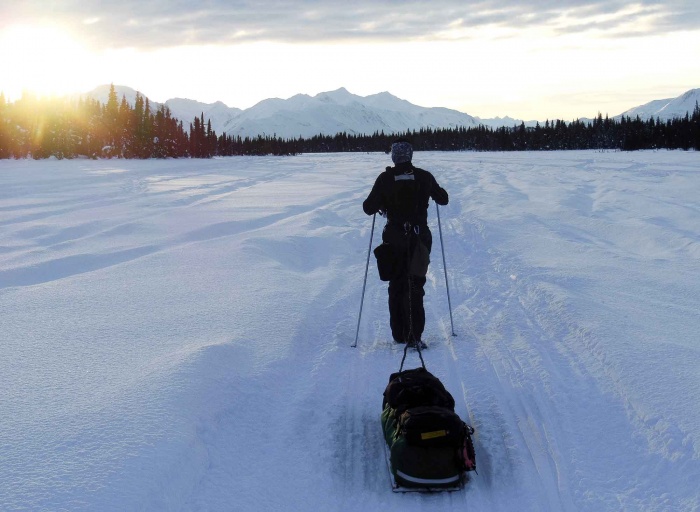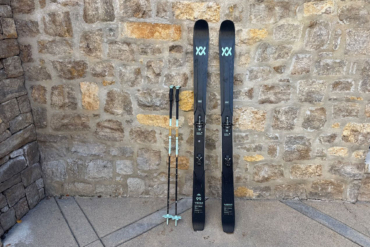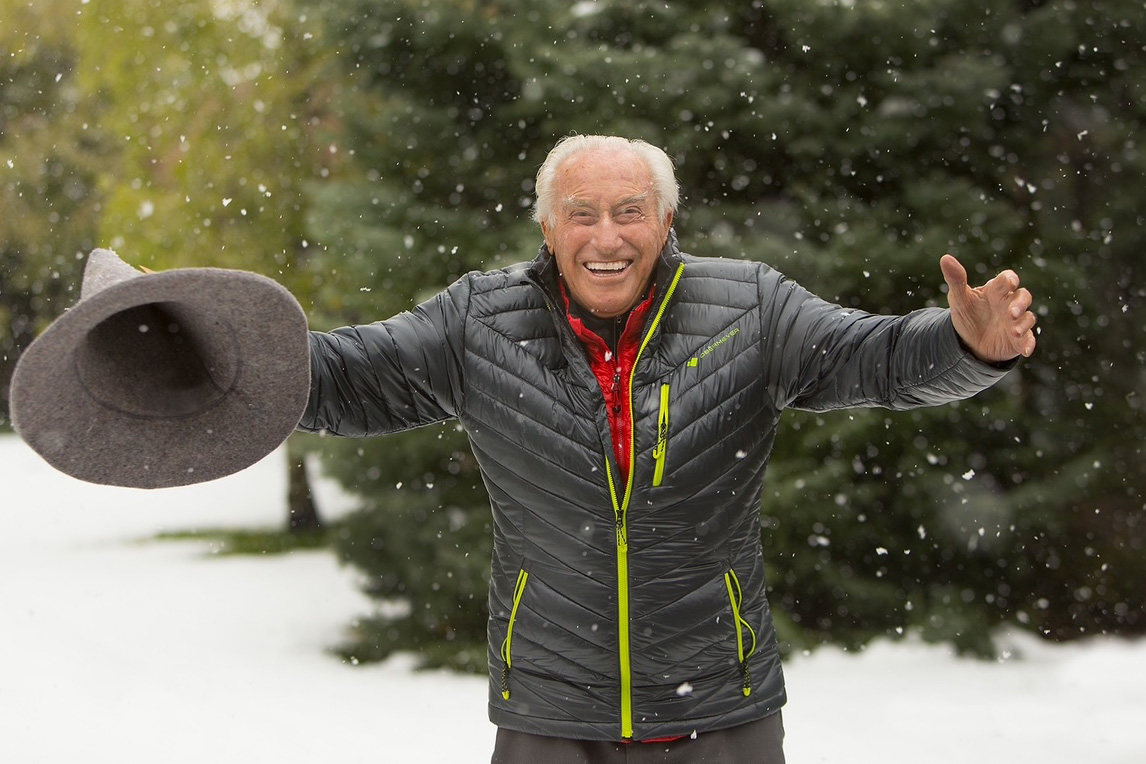Trudging for hours or days across snow without stopping (all while pulling your supplies) is a niche activity embraced by a winter-obsessed sliver of the ultra crowd. Welcome to the sport of winter ultras. Button up.

In this article, veteran snow-slogger John Storkamp divulges his evolution from marathon runner to “human sled dog” over a decade of racing some of the toughest winter ultras on Earth. Read on for a peek into this niche sport and some tips for those ready to dive in.
IN 2013, MY LONG-TIME TRAINING AND RACING partner Matt Long and I participated in the granddaddy of all human-powered winter ultramarathons, the Iditarod Trail Invitational. It requires participants to travel vast distances through remote areas, in the winter, on snow-covered trails, dragging gear for self-sufficient survival.
Seven glorious and challenging days (and 350 miles) later, we reached the finish line in the tiny Alaskan outpost of McGrath. The fat-bikers and front-runners were long since gone.

We decided to stick around a few days. Soon, the Iditarod mushers began arriving at regular intervals. McGrath is an Iditarod checkpoint along the 1,000-mile race ending in the remote village of Nome.
The mushers were swarmed by local children and media covering the race. I looked past the people and caught the eye of a lead dog. After all, we had things in common.
The dog had 350 miles in its legs, but you would never know it. He was wired to run, paused now but staring down a steep chute leading back onto the trail. Nome was calling, and he was ready to go.
Becoming a Sled Dog: Entry Into Winter Ultras
Rewind to the summer of 2006. My friend Pierre Oster was hounding me to do his new race, the Arrowhead 135, which he had created in Minnesota the year before. I was a newb to winter ultras. Pierre, in contrast, was a veteran of the Iditarod Trail Invitational and the Alaska scene.
Oster wanted the experience closer to home. So he set a start line in International Falls—”Icebox of the Nation”—on the Canadian border. The Arrowhead 135 would course south from there, its namesake 135 miles of snowy trail ending in Tower, Minn., where one of the coldest recorded temperatures in the United States was measured at -60 degrees F.
I was a pup ready to go. While I had backpacked, snowshoed, winter camped, and run marathons for nearly a decade, I was newly minted to the ultra scene.
The transformation was about to begin. I found myself in a harness, and I learned to tow a sled. That February, I arrived at the Arrowhead not knowing what was ahead.
Arrowhead 135: In The Harness
At the “GO!” something clicked. I was a sled dog, pulling, trekking, running, and gazing ahead on the trail through wind and across the snow. Hours of motion, quiet forests. Then, the long, black night—below-zero, all alone.
Everything that happened during that event has lived on in me, frozen in my mind. I pressed on, and I got lucky, soon becoming the first person to complete the Arrowhead 135 on foot.

With a lot of trial and error, and many mistakes along the way, I have gone on to complete the Arrowhead 135 nine times. I failed three times at the event too; it’s never guaranteed.
My sled dog spirit wanted to roam. And so I signed up and trained for events further afield, further north and remote. That was how I ended up on the Iditarod Trail.
Today, I am a seasoned sled dog. I’ve learned a lot from the trail, and from my fellow humans slogging to win or just survive in this frozen game. Here are a few “confessions,” some sled-dog knowledge I’ve learned along the way.
How To Thrive In Winter Ultras
Dogs Walk and Run
In a 135-mile race such as the Arrowhead 135, I run 20 miles at the most. The rest I power-hike. While there are some unique individuals that can run continuously 135 miles through snow while pulling a 40-pound sled, I am not one of them.
For me, after two decades of running marathons and ultras, winter ultra-racing is my break from the running motion and running in general. This is not to say that I move slowly. I practice the walk and can sustain 4 mph around the clock for days on end. Due to the resistance of the sled, my heart rate is often as high as if I were running. Consistency and efficiency are the keys to winter ultra success.
I Am Not a Tire Dragger
People drag tires to train for winter ultras. While my Facebook feed is far less interesting than it could be due to the lack of tire-pulling selfies, I have never done it. Instead, I stay strong by running marathons and ultras in the late spring, summer, and early fall. I spend plenty of time in the gym throughout the year, and some of my work is quite physical.
Once the snow flies, I spend long days pulling a sled. Some days I post-hole, others I snowshoe or travel by skis.
Ice Skating is Training Too
Any and all time spent outdoors in the winter is good training in my opinion. Time spent out in the cold is good for acclimatization and being comfortable both physically and psychologically. On a good week, I go for a run or two and a couple walks with my wife. I snowshoe, ski, ice skate, and shoot the puck. I shovel the driveway and might even go sledding or snowboarding.
Winter is a lifestyle, and no time spent outside in the cold is wasted.
Minnesotans Were Made for This
As a Minnesotan, I lack a lot of the things that my mountain-dwelling counterparts have. I don’t have big mountains to ski or climb, and I don’t have an endlessly awesome year-round climate that motivates my friends in the Southwest to stay in great shape, eat great, and always have killer abs.
What we do have in abundance is cold, snow, frozen lakes, and solitude for nearly six months. Thus Minnesotans, like Alaskans and Wisconsinites, are uniquely positioned to be good at winter ultra racing.
There are Advantages to Being Raised on Hotdish and Casserole
Like any good Minnesotan, Hotdish and Casserole were staples growing up. As I became an athlete early in life, my diet never improved much, remaining pretty lousy. Most of the year this does not serve me very well.
But come winter, when the weekly long training session is 12 hours or sometimes longer—with an overnight thrown in and the mercury is well below zero—super-high-calorie foods are a must. As a result of my daily diet being less than stellar, I am able to down Little Debbie’s with no adverse effects and continue charging forward.
I Don’t Race
Getting caught up in racing has handed me more winter ultra DNFs than I am comfortable with. More importantly, I realized that it can put a strain on the event organization and affect the safety of others.
I have first-hand experience helping others get out of some pretty perilous jams they got themselves into by racing a little too hard and not taking care of themselves. Of all of the different types of running and ultramarathon events I participate in, I think winter ultras are the last place to push myself to my absolute limit.
In winter ultra racing, the ability to self-rescue is a must. I can’t self-rescue if I have driven myself into the ground running too hard trying to win the race. I would much rather keep myself intact and let the race organization worry about real issues and real emergencies that may arise.
All of that said, if in the later stages of the race I am doing well, I might get after it a bit if I can see your headlamp in front of me!
All-You-Can-Eat Hallucinations Are Included in the Entry Fee
It’s the stuff of legend: ultramarathon running and the wild hallucinations experienced. I have yet to run a race shorter than two days and above 0 degrees F, where hallucinations were a part of the equation.
But one thing is for certain: Leave me out working hard for two days without sleep at below-zero temperatures, and I am going to ride the neon camel! That is just for starters. For me, sneaking in a cat nap and pounding a ton of calories will usually help keep the hallucinations at bay.
It’s Going to Get Boring
That said, every ultrarunner, mountaineer, and winter-racer knows the equation: boredom + suffering = fun. Right?
On a fat bike in the snow, 10 miles takes around an hour under good conditions. During a road or even trail run, 10 miles might take an hour and a half or two.
But in training and during winter ultra racing on foot, every 10 miles may take three hours or much more. If you like to ponder and think deep thoughts, this is good for you. If you are a music lover, it is a great time to listen to the full Led Zeppelin catalog. I have grown to love the silence and the solitude.
I Wear Six Hats
Years ago when friend and winter racing legend Eric Johnson first told me that he sometimes did not pack a down jacket but always packed six hats, I was a little skeptical. Was he playing mind games with his competition? A few years later during an event, the bottom fell out, with a sustained temp of -38 degrees F (windchill of -60 degrees F) for an entire day.
I had three hoods, a buff, and two hats. I put every single one of them on and all was good. Don’t you remember your mom telling you to put on a stocking hat when you were a kid or recall learning in science class that 40% of your body heat is lost through your head? I never leave home without my six hats anymore.
Winter Ultra Racing is (Mostly) ‘Type Two’ Fun
When I first embarked on this sport, there was nobody local I could talk to about training and racing besides my friend Pierre. This was in the pre-ubiquitous-internet era where you could find answers online for every question, so I contacted famed Alaskan winter ultra racer Rocky Reifenstuhl. Rocky filled my head with more winter racing knowledge in that one phone call than I could have ever hoped for.
The one thing I will never forget was his “Type One vs. Type Two” fun analogy, which he also so eloquently relates in AJ Sauer’s film, The Thin White Line:
“Type One fun is like riding a roller-coaster or having sex: You know it’s fun while you are doing it. Type Two fun is something that is not as much fun while you are doing it but is a lot of fun once it is over, when you can tell the stories.”
Winter ultra racing is a lot of Type Two fun.
–John Storkamp is a Minnesota native. He operates Rocksteady Running and directs a series of trail and ultra races in his home state. See Storkamp’s personal site here.






